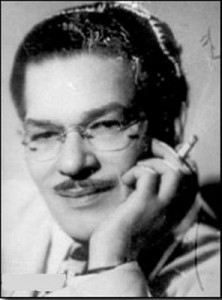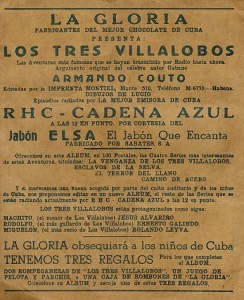No one spoke of “soap opera” or “radio soap opera” until the Cubans invented such terms, and so did the “telenovela”. We invented the terms because before we invented the product. Hence a famous radionovelista yesterday, Iris Davila, expressed for years that the Cubans are to blame for a literary fact connected by the umbilical cord to twentieth century technology and causing no little controversy in intellectual circles in Latin America . He was referring, of course, the narrative transformed and expanded first by radio and then television.
“We take responsibility and confess the sin … Cuba had the audacity to introduce an emerging electronic trade of the old fable, ‘said the author of Divorced and On the ways of life and added:” The Spanish language originated daring genre unusual, more dramatic narrative, because his form was essential elocutiva dialogue and narration, and for how demanding the game histrionic voice modulated, without thereby cease to be novel, that is, more or less slow action and more or less extensive, although not counted in the past but expressed in this. ”
Although one could speak of some previous attempts, from 1919 – Cuban radio was born in 1922. On 10 October of that year, Alfredo Zayas y Alfonso, President of the Republic of Cuba, Cuban radio opened with a speech … in English. He did so from the microphones of a powerful 500-watt station, installed at the headquarters of the Cuban Telephone Company, a subsidiary of ITT. It was the first American radio station in Latin America, and arose, he said, with a “experimental” approach to, in essence, an illiterate and illiterate mass.
Soon after, a primitive network of amateur radio, there were spirited entrepreneurs who planted the Isle of small stations. In 1933 there were 62 radio stations in Cuba that placed the country in this field, leading the continent, surpassed only by the United States and Canada. In Uruguay there were then 25 radio stations, 22 in Brazil and 17 in Argentina.
“The quantitative factor, determining in this case, set the tone and style of the auditions. Quickly, from the beginning, music, humor sparks in declamations and news, national preferences were imposed,” said Iris Davila.
SOAP OPERA
In the U.S., meanwhile, had emerged a radio product reliable: the soap opera. There was a strong interest in Latin America launch, but hoped to do at the right time. Was needed before, as a platform, improved receivers flooding the vast regions of the continent and ensure the usefulness of the business.
In Cuba, however, was gaining ground, perhaps intuitively, in terms of radio content related to a mass of listeners. And in 1934 overlooks the drama here. Born in a station of the city of Santiago de Cuba and its main character is Chan Li Po, a famous Chinese detective would make his statement of “Patience, patience.” Its creator is Felix Benjamin Caignet Solomon.
But Caignet didn’t start from nothing. Others paved his way.
HABIT OF HEARING
In 1929 they said verses and monologues by Cuban radio and radioed in 1931 for the first time something like romantic novel: its author was the famous poet José Angel Buesa. After that gains strength the soap operas, dramas that looked the ingredients-music and sound effects, of what would later be called the radial language. And by that time Caignet itself based on a recollection of his childhood, the popular storytellers, introduced the suspense in a children’s program that wrote then: cut the narration in a climax of the plot and had to wait for the chapter below to find out how the action went on.
By that time began on Cuban radio adaptations of great works of world literature and known pieces of Spanish theater. With that fostered the habit of hearing, which would soon give way to the habit of continuity that would be implemented with the plays that were transmitted at a rate of one event per day.
By then Caignet was premiered in Santiago de Cuba, the first series of Chan Li Po. In 1937 comes to Havana and gets a contract at a station of the second row. But there would last a short time, a powerful transmitter and transmits the tab for about eight years running the subtle deductions punter crimes detective and uncertainties that pleases an audience increasingly mainstream.
At the same time CMQ asks his listeners to suggest titles of the novels that they would like to hear. They adapt well to the radio works like 24 hours in the life of a woman, Zweig, You are peace, Martínez Sierra, the man I loved, Rostand, and Wuthering Heights, Bronte. These are the years when the great Cuban writer Alejo Carpentier narrator makes for radio versions of famous novels and a chapter of one-hour condensed titles like The Charterhouse of Parma, Quo Vadis, The Four Horsemen of the Apocalypse …
Soap opera from the HEART
The drama of the heart itself arose in 1941 when the RHC Cadena Azul began his Air Space The Novel. The first title in this line is Cuba’s city rolls a cry, Reynaldo Lopez del Rincon, adapter until then great novels. Lopez del Rincon, with his work, made public harvest and opened a whole stage.
In 1944 Caignet premieres The price of a life, and two years later, worse than snakes confirms its popularity. As early as 1945 appears necklace of tears, Pepito Sanchez Clay, with its 965 chapters is the longest novel that made the Cuban radio in its history. In 1946 the air out here between 25 and 30 daily soap operas. In 1948, he radiates the right to be born, and its author, Felix B. Caignet, stands at the head of the writers of the genre.
During that time arise, among others, the essential names Iris Dávila, Hilda Morales, Caridad Bravo Adams, Dora Alonso, René Alouis, Aleida Amaya … that account, each with its own style, the pro-Cuban and other listeners latitudes because it was not surprising that his works in ten or twelve trasmitiesen nations.
When television is introduced in Cuba in 1950, many authors radial incursion, sometimes to stay in the new medium. Other names emerge. Some, Iris Davila, Aleida Amaya, Roberto Garriga … – adapt to new circumstances. Others have a less extensive and decisive presence or decide to stay on the radio.
Blunts the soap opera-our-needed Iris Davila. Considered globally such a dynamic creative vitality involves disproportionate, dizzying, of extraordinary importance in the cultural sociological Cuban the 50’s where 24% still remained illiterate and where artistic and literary manifestations were inaccessible to the public.
Death and Resurrection
Already in the 60 execrated the serial on the radio and television in Cuba. He cut his natural process and lost much of its resources and techniques. By then Caignet had stopped writing, and Iris Davila. Rene was engaged Alouis Medicine. Hilda Morales wrote only two dramas between 1959 and 1967. Other authors before, as Aleida Amaya, were added to the times, but in the TV serial had given way in the Horizons series, to which the public called “the novel of the unions” without trying to maintain good resources and the hooks of the “novella”.
On radio, the thing was no better. It is an unwritten history. The day came to ICR-T a director who wanted no more serials. It is unknown whether the idea was generated in his own head and, though not openly expressed, the writers picked up their signs and began to act accordingly. But the decision was more dramatic than it initially appeared one day and ordered all radio dramas on the air of a finalized overnight. What happened is easy to imagine. The order was fulfilled, but the stations were virtually no programming.
Enrique Nunez Rodriguez, who then wrote again to the radio, did not escape that fate. Once told to Leonardo Moncada, that series of adventures that epoch in his life. He was summoned to the address of the organization and asked him to put his character to right wrongs in Latin America. Henry refused course, stopped writing the series and the new writer was entrusted to kill Moncada. Shortly after that director was replaced and the people gave a title to his demotion very radial. He called Revenge of Moncada.
The serial again on his own feet in 1992 when Radio Progreso transmitted Beyond love, Josefina Martinez. Passion and Prejudice, by Eduardo Macias, marked a milestone in television in this regard. And in 1996, on the radio, When life becomes, Joaquín Cuartas, caused a phenomenon unknown in the Isle hearing from many years before. Fourth, to write, wanted to know if Caignet mechanisms still functioned, and results showed that yes, as in the days of the right of birth, the country was paralyzed back to the time of transmission. Blocks not repeated to Caignet. He paid tribute to the classic serial so without ignoring the gains of modern communication. And is that the serial like it because it exacerbates all the dramatic elements.
The man acts, loves, hates and suffers driven by moral forces and myths that come from ancient Greece. Man needs to be told stories and dramas and soap operas that play in the function yesterday were the minstrels and the epic poems, the novels of chivalry and the serial novel of the Romantics. The common man is still needed to be done on a project outside triumphant. It is said that whoever hears or sees a serial, not see or hear a novel, but visiting a house in the most interesting things happen in their own. It makes the viewer in a gossip: that the protagonist knows things and wants to know from your living gritárselas and thus plays a role in this trap that is the plot of the serial.
Sources: CiroBianchiRoss/InternetPhotos/YouTube/www.thecubanhistory.com
SOAP OPERA and “TELENOVELAS”. A Cuba’s Original.
The Cuban History, Arnoldo Varona
“LA RADIO Y TELENOVELAS”. UNA CREACIÓN CUBANA.
Nadie hablaba de “radionovela” ni de “novela radial” hasta que los cubanos inventamos dichos términos, y lo mismo sucedió con el de “telenovela”. Inventamos los términos porque antes habíamos inventado el producto. De ahí que una famosísima radionovelista de ayer, Iris Dávila, expresara hace años que los cubanos son los culpables de un hecho literario unido por el cordón umbilical a la tecnología del siglo XX y causante de no pocas polémicas en los círculos intelectuales de la América Latina. Aludía, por supuesto, a la narrativa transformada y expandida primero por la radio y luego por la televisión.
“Asumimos la responsabilidad y confesamos el pecado… Cuba tuvo la osadía de introducir en un incipiente sistema electrónico el viejo oficio de fabular –decía la autora de Divorciadas y Por los caminos de la vida y añadía: “El atrevimiento originó en lengua hispana un género insólito, más dramático que narrativo, por cuanto su forma elocutiva esencial era el diálogo y no la narración, y por cuanto demandaba el juego histriónico de voces moduladas, sin que por ello dejara de ser novela, o sea, acción más o menos lenta y más o menos amplia, si bien no contada en pretérito sino expresada en presente.”
Aunque podría hablarse de algunos intentos anteriores –a partir de 1919- la radio cubana nació en 1922. El 10 de octubre de ese año, Alfredo Zayas y Alfonso, Presidente de la República de Cuba, inauguraba la radio cubana con un discurso que pronunció… en inglés. Lo hizo desde los micrófonos de una poderosa emisora de 500 watts, instalada en la sede de la Compañía Cubana de Teléfonos, subsidiaria de la ITT. Era la primera emisora norteamericana en la América Latina, y surgió, se dijo, con un carácter “experimental” a fin de acercarse, en esencia, a una gran masa analfabeta e iletrada.
Poco después, de una primitiva red de radioaficionados, surgieron emprendedores animosos que sembraron la Isla de emisoras pequeñas. En 1933 había en Cuba 62 radioemisoras que situaban al país, en este campo, a la cabeza del continente, solo superado por Estados Unidos y Canadá. En Uruguay había entonces 25 estaciones de radio, 22 en Brasil y 17 en la Argentina.
“El factor cuantitativo, determinante en este caso, marcó la tónica y el estilo de las audiciones. Con rapidez, desde el principio, en música, en chispazos humorísticos, en declamaciones y noticias, se impusieron las preferencias nacionales” –afirmaba Iris Dávila.
SOAP OPERA – RADIONOVELA
En Estados Unidos, mientras tanto, había surgido un producto radiofónico eficaz: la soap opera. Existía allí un vivo interés por lanzarlo en la América Latina, pero esperaban hacerlo en el momento propicio. Se necesitaba antes, como plataforma, inundar de aparatos receptores perfeccionados las vastas regiones del continente y asegurar así la utilidad del negocio.
En Cuba, sin embargo, se iba ganando terreno, acaso por intuición, en cuanto a los contenidos radiofónicos afines a una gran masa de oyentes. Y ya en 1934 asoma aquí la radionovela. Nace en una emisora de la ciudad de Santiago de Cuba y tiene como protagonista a Chan Li Po, un detective chino que haría célebre su frase de “Paciencia, mucha paciencia”. Su creador es Félix Benjamín Caignet Salomón.
Pero Caignet no partió de la nada. Otros autores le abonaron el camino.
HÁBITO DE AUDIENCIA
Ya en 1929 se decían versos y monólogos por la radio cubana, y en 1931 se radió por primera vez algo muy parecido a una novela amorosa: su autor fue el célebre poeta José Ángel Buesa. A partir de ahí gana fuerza el radioteatro, dramatizaciones que contemplaban los ingredientes –música y efectos sonoros- de lo que después se llamaría el lenguaje radial. Y por esa misma época el propio Caignet, basándose en un recuerdo de su niñez, el de los cuenteros populares, introdujo el suspenso en un programa infantil que escribía entonces: cortaba la narración en un momento culminante de la trama y había que esperar al capítulo siguiente para enterarse de cómo proseguía la acción.
Por ese tiempo comenzaban en la radio cubana las adaptaciones de grandes obras de la literatura universal y de piezas conocidas del teatro español. Con eso se fomentó el hábito de audiencia, que no tardaría en dar paso al hábito de continuidad que se implantaría con las obras de teatro que se trasmitían a razón de un acto por día.
Por entonces Caignet estaba estrenando, en Santiago de Cuba, la primera serie de su Chan Li Po. En 1937 viene a La Habana y logra un contrato en una emisora de segunda fila. Pero allí duraría poco tiempo; una emisora poderosa lo ficha y trasmite durante unos ocho años consecutivos las sutiles deducciones del detective despejador de crímenes e incógnitas que complace a un auditorio cada vez más mayoritario.
En esa misma época CMQ pide a sus oyentes que sugieran los títulos de las novelas que les gustaría escuchar. Se adaptan así para la radio obras como 24 horas en la vida de una mujer, de Zweig, Tú eres la paz, de Martínez Sierra, El hombre que yo amé, de Rostand, y Cumbres borrascosas, de Bronte. Son los años en que el gran narrador cubano Alejo Carpentier hace para la radio versiones de novelas famosas y en un capítulo de una hora de duración condensa títulos como La cartuja de Parma, Quo vadis, Los cuatro jinetes del Apocalipsis…
RADIONOVELA DEL CORAZÓN
La radionovela del corazón propiamente dicha surgió en 1941, cuando la RHC Cadena Azul inicia su espacio La Novela del Aire. El primer título original cubano en esa línea es Por la ciudad rueda un grito, de Reynaldo López del Rincón, adaptador hasta entonces de grandes novelas. López del Rincón, con su obra, hizo zafra de público e inauguró toda una etapa.
En 1944 Caignet estrena El precio de una vida, y, dos años después, con Peor que las víboras ratifica su popularidad. Ya en 1945 aparece El collar de las lágrimas, de Pepito Sánchez Arcilla, que con sus 965 capítulos es la novela más larga que ha trasmitido la radio cubana en toda su historia. En 1946 salían al aire aquí entre 25 y 30 radionovelas diarias. En 1948 se radia El derecho de nacer, y su autor, Félix B. Caignet, se sitúa a la cabeza de los escritores del género.
En ese periodo surgen, entre otros, los nombres imprescindibles de Iris Dávila, Hilda Morales, Caridad Bravo Adams, Dora Alonso, René Alouis, Aleida Amaya… que acaparan, cada uno de ellos con estilo propio, el favor de radioescuchas cubanos y de otras latitudes pues no era extraño que sus obras se trasmitiesen en diez o doce naciones.
Cuando se introduce la televisión en Cuba, en 1950, muchos autores radiales incursionaron, en ocasiones para quedarse, en el nuevo medio. Surgen otros nombres. Algunos –Iris Dávila, Aleida Amaya, Roberto Garriga…- se adaptan a las nuevas circunstancias. Otros tendrían una presencia menos amplia y determinante o deciden mantenerse en la radio.
-Despunta la telenovela nuestra –precisaba Iris Dávila. Considerada globalmente semejante vitalidad implica una dinámica creativa desmesurada y vertiginosa, de extraordinario relieve sociológico en el contexto cultural cubano de la década del 50 donde aún persistía un 24% de analfabetos y donde las manifestaciones artístico-literarias eran inaccesibles para el gran público.
MUERTE Y RESURRECCIÓN
Ya en los 60 se execró el folletín en la radio y la televisión cubanas. Se cortó su proceso natural y se perdieron muchos de sus recursos y sus técnicas. Ya para entonces Caignet había dejado de escribir, y también Iris Dávila. René Alouis se dedicaba a la Medicina. Hilda Morales escribiría solo dos radionovelas entre 1959 y 1967. Otros autores de antes, como Aleida Amaya, se sumaban a los nuevos tiempos, pero en la TV el folletín había dado paso, en la serie Horizontes, a lo que el público llamó “la novela de los sindicatos”, sin bien trataba de mantener los recursos y los ganchos de la “novelita”.
En la radio, la cosa no fue mejor. Es una historia no escrita. Llegó un día al ICR-T un director que no quería más folletines. Se desconoce si la idea se generó en su propia cabeza y, aunque no la expresó abiertamente, los escritores captaron sus señas y empezaron a actuar en consecuencia. Pero la decisión era más drástica de lo que en un inicio parecía y un día ordenó que todas las radionovelas en el aire finalizaran de un día para otro. Lo que sucedió es fácil de imaginar. La orden se cumplió, pero las emisoras quedaron prácticamente sin programación.
Enrique Núñez Rodríguez, que entonces escribía aún para la radio, no escapó a esa suerte. Contó una vez el fin de Leonardo Moncada, aquella serie de aventuras que hizo época en sus días. Lo convocaron a la dirección del organismo y le pidieron que pusiera a su personaje a deshacer entuertos en la América Latina. Enrique lógicamente se negó, dejó de escribir el serial y el nuevo escritor recibió la encomienda de matar a Moncada. Poco después aquel director era sustituido y la gente dio un título muy radial a su democión. Le llamó La venganza de Moncada.
El folletín volvería por sus propios pies en 1992 cuando Radio Progreso trasmitió Más allá del amor, de Josefina Martínez. Pasión y prejuicio, de Eduardo Macías, marcó en la televisión un hito en este sentido. Y en 1996, en la radio, Cuando la vida vuelve, de Joaquín Cuartas, provocaba un fenómeno de audiencia desconocido en la Isla desde muchos años antes. Cuartas, al escribirla, quiso saber si los mecanismos de Caignet funcionaban todavía, y resultado demostró que sí, que, como en los días de El derecho de nacer, el país se paralizaba de nuevo a la hora de la trasmisión. Cuadras no repetía a Caignet. Pagaba tributo al folletín clásico sin desdeñar por ello las ganancias de la comunicación moderna. Y es que el folletín gusta porque en él se exacerban todos los elementos dramáticos.
El hombre actúa, ama, odia y sufre impulsado por fuerzas y mitos morales que vienen de la antigua Grecia. El hombre necesita que le cuenten historias y las radionovelas y las novelas de televisión cumplen en eso la función que ayer tuvieron los juglares y los cantares de gesta, las novelas de caballería y la novela por entregas de los románticos. El hombre común sigue necesitado de verse realizado en un proyecto ajeno triunfante. Se dice que quien escucha o ve un folletín, no ve ni oye una novela, sino que visita una casa en la que ocurren cosas más interesantes que en la propia. Convierte al espectador en un chismoso: sabe cosas que el protagonista desconoce y quiere gritárselas desde su sala y juega así un papel dentro de esa trampa que es la trama del folletín.
Sources: CiroBianchiRoss/InternetPhotos/YouTube/www.thecubanhistory.com
SOAP OPERA and “TELENOVELAS”. A Cuba’s Original.
The Cuban History, Arnoldo Varona









